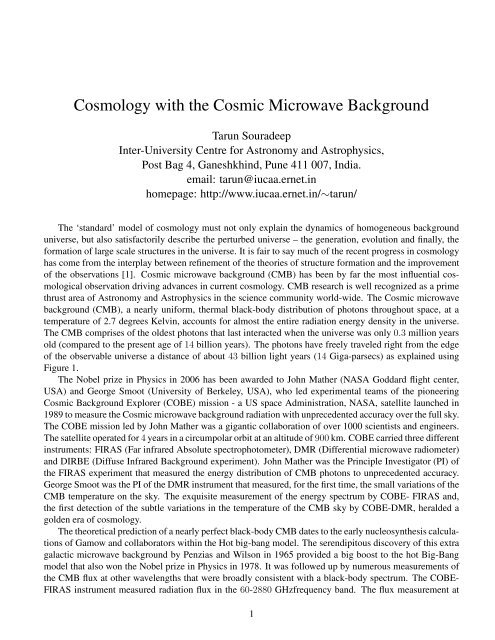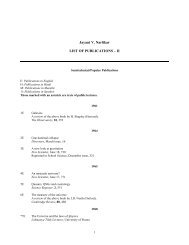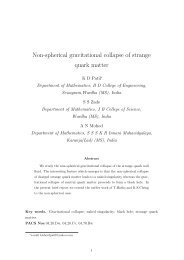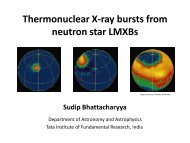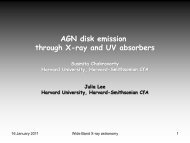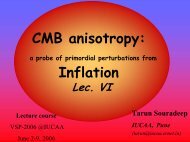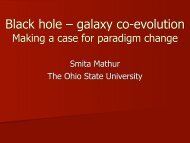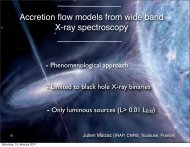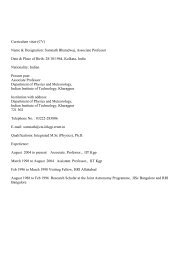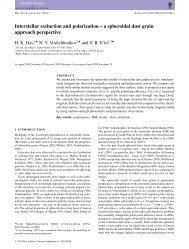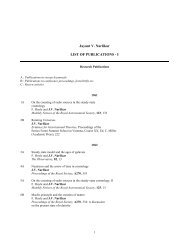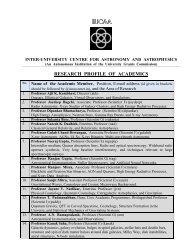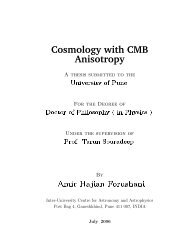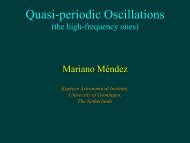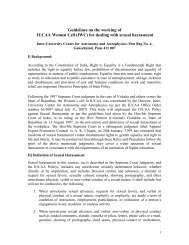Cosmology with the Cosmic Microwave Background - iucaa
Cosmology with the Cosmic Microwave Background - iucaa
Cosmology with the Cosmic Microwave Background - iucaa
You also want an ePaper? Increase the reach of your titles
YUMPU automatically turns print PDFs into web optimized ePapers that Google loves.
<strong>Cosmology</strong> <strong>with</strong> <strong>the</strong> <strong>Cosmic</strong> <strong>Microwave</strong> <strong>Background</strong><br />
Tarun Souradeep<br />
Inter-University Centre for Astronomy and Astrophysics,<br />
Post Bag 4, Ganeshkhind, Pune 411 007, India.<br />
email: tarun@<strong>iucaa</strong>.ernet.in<br />
homepage: http://www.<strong>iucaa</strong>.ernet.in/∼tarun/<br />
The ‘standard’ model of cosmology must not only explain <strong>the</strong> dynamics of homogeneous background<br />
universe, but also satisfactorily describe <strong>the</strong> perturbed universe – <strong>the</strong> generation, evolution and finally, <strong>the</strong><br />
formation of large scale structures in <strong>the</strong> universe. It is fair to say much of <strong>the</strong> recent progress in cosmology<br />
has come from <strong>the</strong> interplay between refinement of <strong>the</strong> <strong>the</strong>ories of structure formation and <strong>the</strong> improvement<br />
of <strong>the</strong> observations [1]. <strong>Cosmic</strong> microwave background (CMB) has been by far <strong>the</strong> most influential cosmological<br />
observation driving advances in current cosmology. CMB research is well recognized as a prime<br />
thrust area of Astronomy and Astrophysics in <strong>the</strong> science community world-wide. The <strong>Cosmic</strong> microwave<br />
background (CMB), a nearly uniform, <strong>the</strong>rmal black-body distribution of photons throughout space, at a<br />
temperature of 2.7 degrees Kelvin, accounts for almost <strong>the</strong> entire radiation energy density in <strong>the</strong> universe.<br />
The CMB comprises of <strong>the</strong> oldest photons that last interacted when <strong>the</strong> universe was only 0.3 million years<br />
old (compared to <strong>the</strong> present age of 14 billion years). The photons have freely traveled right from <strong>the</strong> edge<br />
of <strong>the</strong> observable universe a distance of about 43 billion light years (14 Giga-parsecs) as explained using<br />
Figure 1.<br />
The Nobel prize in Physics in 2006 has been awarded to John Ma<strong>the</strong>r (NASA Goddard flight center,<br />
USA) and George Smoot (University of Berkeley, USA), who led experimental teams of <strong>the</strong> pioneering<br />
<strong>Cosmic</strong> <strong>Background</strong> Explorer (COBE) mission - a US space Administration, NASA, satellite launched in<br />
1989 to measure <strong>the</strong> <strong>Cosmic</strong> microwave background radiation <strong>with</strong> unprecedented accuracy over <strong>the</strong> full sky.<br />
The COBE mission led by John Ma<strong>the</strong>r was a gigantic collaboration of over 1000 scientists and engineers.<br />
The satellite operated for 4 years in a circumpolar orbit at an altitude of 900 km. COBE carried three different<br />
instruments: FIRAS (Far infrared Absolute spectrophotometer), DMR (Differential microwave radiometer)<br />
and DIRBE (Diffuse Infrared <strong>Background</strong> experiment). John Ma<strong>the</strong>r was <strong>the</strong> Principle Investigator (PI) of<br />
<strong>the</strong> FIRAS experiment that measured <strong>the</strong> energy distribution of CMB photons to unprecedented accuracy.<br />
George Smoot was <strong>the</strong> PI of <strong>the</strong> DMR instrument that measured, for <strong>the</strong> first time, <strong>the</strong> small variations of <strong>the</strong><br />
CMB temperature on <strong>the</strong> sky. The exquisite measurement of <strong>the</strong> energy spectrum by COBE- FIRAS and,<br />
<strong>the</strong> first detection of <strong>the</strong> subtle variations in <strong>the</strong> temperature of <strong>the</strong> CMB sky by COBE-DMR, heralded a<br />
golden era of cosmology.<br />
The <strong>the</strong>oretical prediction of a nearly perfect black-body CMB dates to <strong>the</strong> early nucleosyn<strong>the</strong>sis calculations<br />
of Gamow and collaborators <strong>with</strong>in <strong>the</strong> Hot big-bang model. The serendipitous discovery of this extra<br />
galactic microwave background by Penzias and Wilson in 1965 provided a big boost to <strong>the</strong> hot Big-Bang<br />
model that also won <strong>the</strong> Nobel prize in Physics in 1978. It was followed up by numerous measurements of<br />
<strong>the</strong> CMB flux at o<strong>the</strong>r wavelengths that were broadly consistent <strong>with</strong> a black-body spectrum. The COBE-<br />
FIRAS instrument measured radiation flux in <strong>the</strong> 60-2880 GHzfrequency band. The flux measurement at<br />
1
time<br />
Redshift z=0<br />
Here&now<br />
Post recombination<br />
transparent universe<br />
Redshift z=1100<br />
CMB Sky<br />
R<br />
H<br />
Hypersurface of last scattering<br />
(epoch of recombination)<br />
Ionized &<br />
Opaque universe<br />
Figure 1: A cartoon explaining <strong>the</strong> <strong>Cosmic</strong> <strong>Microwave</strong> <strong>Background</strong> (CMB) using a space-(conformal) time<br />
diagram The present universe is transparent and CMB photons travel to us freely over cosmic distances along<br />
our past light cone. In an expanding universe, <strong>the</strong> temperature of <strong>the</strong> Planck Black-body CMB is inversely<br />
proportional to <strong>the</strong> expansion factor. When <strong>the</strong> universe is about 1100 times smaller, <strong>the</strong> CMB photons<br />
are hot enough to keep <strong>the</strong> baryonic matter in <strong>the</strong> universe (about 3 quarters Hydrogen, 1 quarter Helium)<br />
ionized, accompanied by a sharp transition to an opaque universe. The CMB photons unimpeded come to<br />
us directly from this Spherical opaque surface of last scattering at distance of R H = 14 Gpc that surrounds<br />
us – a super IMAX cosmic screen. The red circle depicts <strong>the</strong> sphere of last scattering in <strong>the</strong> reduced 2 + 1<br />
dimensional representation of <strong>the</strong> universe.<br />
2
Figure 2: The figure shows a selected compilation of <strong>the</strong> best measurements of <strong>the</strong> energy spectrum of <strong>the</strong><br />
CMB photons as a function of frequency. The distribution is extremely well fit by a black-body spectrum at<br />
a temperature of T 0 = 2.726(±0.002) making <strong>the</strong> CMB <strong>the</strong> most perfect Black-body known in nature. The<br />
blue measurement points around <strong>the</strong> peak (from 60-600 GHz.) are from <strong>the</strong> FIRAS instrument on board <strong>the</strong><br />
COBE satellite that won <strong>the</strong> Nobel prize in Physics in 2006. The figure has been obtained from <strong>the</strong> website<br />
of <strong>the</strong> ARCADE experiment that has recently made accurate measurements of <strong>the</strong> temperature at a lower<br />
frequency of 10 GHz.<br />
a given frequency can be converted into an equivalent <strong>the</strong>rmodynamic temperature for <strong>the</strong> CMB. FIRAS<br />
established that <strong>the</strong> energy spectrum of CMB photons in <strong>the</strong> frequency range of 60-600 GHz is accurately<br />
described by a perfect black-body distribution at a precisely determined temperature of T 0 = 2.726 ± 0.002<br />
Kelvin. Possible deviations from a perfect black-body spectrum have to be smaller than a hundredth of<br />
a percent of <strong>the</strong> peak brightness. This result alone ruled out alternate, non-cosmic (local astrophysical)<br />
interpretations of microwave background, and established CMB as <strong>the</strong> relic of Big Bang – poetically, <strong>the</strong><br />
‘afterglow of cosmic creation’.<br />
The CMB photons arriving from different directions in <strong>the</strong> sky show tiny variations in temperature, at<br />
a level of ten parts per million, i.e., tens of micro-Kelvin, referred to as <strong>the</strong> CMB anisotropy, and a net<br />
linear polarization pattern at micro-Kelvin to tens of nano-Kelvin level. The tiny variation of temperature<br />
and linear polarization of <strong>the</strong>se black-body photons of <strong>the</strong> cosmic microwave background arriving from<br />
different directions in <strong>the</strong> sky faithfully encodes information about <strong>the</strong> early universe and have traveled<br />
unimpeded across observable universe making <strong>the</strong>m excellent probe of <strong>the</strong> universe. The <strong>Cosmic</strong> microwave<br />
background radiation sky is essentially a giant, cosmic ‘super’ IMAX <strong>the</strong>ater screen surrounding us at a<br />
distance of 14 Gpc <strong>with</strong> a snapshot of <strong>the</strong> universe at a time very close to its origin. This is illustrated in <strong>the</strong><br />
cartoon in Figure 1.<br />
It is convenient to express <strong>the</strong> sky map of <strong>the</strong> CMB temperature anisotropy in <strong>the</strong> direction ˆn as a<br />
spherical harmonic expansion : ∆T (ˆn) = ∑ ∞ ∑ l<br />
l=2 m=−l a lmY lm (ˆn) . Theory predicts that <strong>the</strong> primary CMB<br />
anisotropy is a zero mean Gaussian field that is statistically orientation independent (statistical isotropy).<br />
Current observations remain fully consistent <strong>with</strong> this expectation. The anisotropy can <strong>the</strong>n be characterized<br />
solely in terms an angular spectrum C l = 〈|a lm | 2 〉, where <strong>the</strong> angular brackets imply ensemble average.<br />
3
The C l spectra for wide variety of models share a generic set of features neatly related to basics physics<br />
of primary CMB anisotropy. The anisotropy in <strong>the</strong> cosmic afterglow carries a well preserved and easily<br />
decipherable record of <strong>the</strong> tiny seed perturbations that eventually gave rise to every bit of <strong>the</strong> grand structures<br />
observed in <strong>the</strong> universe - <strong>the</strong> galaxies, clusters and super-clusters of galaxies. On <strong>the</strong> large angular scales<br />
(low multipole l), <strong>the</strong> CMB anisotropy directly probes <strong>the</strong> primordial power spectrum on scales enormously<br />
larger than <strong>the</strong> ‘causal horizon’. On smaller angular scales, <strong>the</strong> CMB temperature fluctuations probe <strong>the</strong><br />
physics of <strong>the</strong> coupled baryon-photon fluid through <strong>the</strong> imprint of <strong>the</strong> acoustic oscillations in <strong>the</strong> ionized<br />
plasma sourced by <strong>the</strong> same primordial fluctuations. The physics of CMB anisotropy is well understood, <strong>the</strong><br />
predictions of <strong>the</strong> linear primary anisotropy and <strong>the</strong>ir connection to observables are unambiguous [2].<br />
The transition to precision cosmology has been spearheaded by <strong>the</strong> measurements of CMB anisotropy<br />
and, more recently, polarization. The COBE-DMR detection of CMB anisotropy observationally established<br />
<strong>the</strong> origin and mechanism of structure formation in <strong>the</strong> universe. Observations were made at three frequencies,<br />
90, 53 and 31 GHz which allowed a fairly good removal of <strong>the</strong> ‘foreground’ contamination of <strong>the</strong><br />
cosmic signal by <strong>the</strong> strong emission from our own galaxy. The 15 years old experimental success story<br />
CMB anisotropy measurements, starting from discovery of CMB anisotropy by <strong>the</strong> COBE satellite in 1992<br />
has been topped off by <strong>the</strong> exquisite data from <strong>the</strong> Wilkinson <strong>Microwave</strong> Anisotropy Probe (WMAP) of<br />
NASA first released in 2003 and again in 2006. The WMAP space mission was launched in July 2001. The<br />
satellite is placed at <strong>the</strong> second Lagrange point of <strong>the</strong> Sun-Earth system. Measurements from <strong>the</strong> Wilkinson<br />
<strong>Microwave</strong> Anisotropy Probe combine high angular resolution <strong>with</strong> full sky coverage and high sensitivity<br />
due to <strong>the</strong> stable <strong>the</strong>rmal environment allowed by a space mission. Similar to <strong>the</strong> observational strategy of<br />
COBE-DMR, <strong>the</strong> satellite measures CMB temperature differences between a pair of points in <strong>the</strong> sky. Each<br />
day <strong>the</strong> satellite covers 30% of <strong>the</strong> sky, but covers <strong>the</strong> full sky in 6 months. This massive redundancy in measurements<br />
allows <strong>the</strong> mission to beat down <strong>the</strong> detector noise to from milli-Kelvins to tens of micro-Kelvin<br />
level. The WMAP mission plans to continue to acquire data for eight years and make that public at regular<br />
intervals after a short proprietary possession.<br />
The public availability of <strong>the</strong>se remarkable data sets have prompted intense activity in research groups<br />
worldwide and has ushered in a new scientific sociology of global participation. A collaboration between<br />
groups at IUCAA and IIT Kanpur, has developed a method of estimating <strong>the</strong> CMB power spectrum solely<br />
from multi-frequency data from WMAP that evades <strong>the</strong> modeling uncertainties involved in using extraneous<br />
foreground maps. The Indian group carried out a completely model free removal of <strong>the</strong> foreground contamination<br />
and an independent estimation of <strong>the</strong> angular power spectrum from WMAP data releases shown in <strong>the</strong><br />
figure 3. Data archive sites such as <strong>the</strong> Legacy Archive of <strong>Microwave</strong> <strong>Background</strong> Analysis (LAMBDA) are<br />
excellent up to date repository for any researcher seeking to work in this field from anywhere in <strong>the</strong> world.<br />
The angular power spectrum of <strong>the</strong> <strong>Cosmic</strong> <strong>Microwave</strong> <strong>Background</strong> temperature fluctuations, C l , have<br />
become invaluable observables for constraining cosmological models. The position and amplitude of <strong>the</strong><br />
peaks and dips of <strong>the</strong> C l are sensitive to important cosmological parameters, such as, <strong>the</strong> relative density<br />
(<strong>with</strong> respect to <strong>the</strong> critical density) of dark matter, Ω m ; cosmological constant, Ω Λ ; baryon content, Ω B ;<br />
Hubble constant, H 0 and deviation from flatness (curvature), Ω K . The measurements of <strong>the</strong> anisotropy in <strong>the</strong><br />
cosmic microwave background (CMB) over <strong>the</strong> past decade has led to ‘precision cosmology’. Observations<br />
of <strong>the</strong> large scale structure in <strong>the</strong> distribution of galaxies, high redshift supernova, and more recently, CMB<br />
polarization, have provided <strong>the</strong> required complementary information. The observation establish that <strong>the</strong><br />
space on cosmic scales is geometrically flat (Ω K = 0) to <strong>with</strong>in 2%. The dominant energy content in<br />
<strong>the</strong> present universe is a mysterious matter <strong>with</strong> negative pressure dubbed, dark energy or a cosmological<br />
constant of about 73% (Ω Λ = 0.73), followed by cold non-baryonic dark matter about 23% (Ω m = 0.23) and<br />
ordinary matter (baryons) account for only about 4% (Ω B = 0.04) of <strong>the</strong> matter budget. The exact numbers<br />
4
6000<br />
Best fit ΛCDM model<br />
1yr<br />
3yr<br />
5000<br />
4000<br />
l(l+1)C l /(2π) [µ K 2 ]<br />
3000<br />
2000<br />
1000<br />
0<br />
1 10 100<br />
200 400 600 800<br />
Multipole, l<br />
Figure 3: The exquisite temperature anisotropy data from <strong>the</strong> three years of data from WMAP satellite is<br />
shown in <strong>the</strong> figures. Top: The top figure shows color coded full sky map (in Mollewide projection)of <strong>the</strong><br />
CMB temperature variations. The temperature variations are range between ±200µK <strong>with</strong> a r.m.s. of about<br />
70µK. The angular resolution of features of <strong>the</strong> map is about a quarter of a degree. For comparison, <strong>the</strong><br />
first CMB anisotropy measurements in 1992 by <strong>the</strong> DMR instrument on board <strong>the</strong> COBE satellite produced<br />
<strong>the</strong> same map at a much coarser resolution of 7 degrees. Bottom: The lower figure plots <strong>the</strong> angular power<br />
spectrum from WMAP-1year (red) and WMAP-3 year (blue) data is shown. The solid line is <strong>the</strong> <strong>the</strong>oretical<br />
prediction of <strong>the</strong> best fit cosmological model. The results shown in <strong>the</strong>se figure have been obtained using<br />
a novel, blind estimation method developed in India by R. Saha, P. Jain and T. Souradeep and is in good<br />
agreement <strong>with</strong> that obtained by <strong>the</strong> WMAP team.<br />
5
are known <strong>with</strong> good statistical precision, but do systematically depend on <strong>the</strong> data-sets used and parameter<br />
spaces of <strong>the</strong> cosmological models. Hence, in this rapidly moving field of research <strong>the</strong> current up to date<br />
status of cosmological parameter estimates from joint analysis of CMB anisotropy and Large scale structure<br />
(LSS) data is usually best to look up in <strong>the</strong> literature accompanying <strong>the</strong> most recent major experimental<br />
results.<br />
In addition to <strong>the</strong> temperature anisotropy, <strong>the</strong>re is linear polarization information (Q and U Stokes parameters)<br />
imprinted on <strong>the</strong> CMB at last scattering surface. Thomson scattering generates CMB polarization<br />
anisotropy at decoupling. This arises from <strong>the</strong> polarization dependence of <strong>the</strong> differential cross section. A<br />
local quadrupole temperature anisotropy produces a net polarization, because of <strong>the</strong> cos 2 θ dependence of<br />
<strong>the</strong> cross section. A net pattern of linear polarization is retained due to local quadrupole intensity anisotropy<br />
of <strong>the</strong> CMB photon flux around <strong>the</strong> electrons at <strong>the</strong> surface of last scattering. The coordinate–free description<br />
distinguishes two kinds of polarization pattern on <strong>the</strong> sky by <strong>the</strong>ir different parities. In <strong>the</strong> spinor<br />
approach, <strong>the</strong> even parity pattern is called <strong>the</strong> E–mode and <strong>the</strong> odd parity pattern <strong>the</strong> B–mode. With <strong>the</strong><br />
introduction of polarization, <strong>the</strong>re are a total of 4 power spectra to determine: Cl<br />
TT , Cl<br />
TE , Cl<br />
EE , Cl<br />
BB ; parity<br />
considerations eliminate <strong>the</strong> two o<strong>the</strong>r possible power spectra. While CMB temperature anisotropy can also<br />
be generated during <strong>the</strong> propagation of <strong>the</strong> radiation from <strong>the</strong> last scattering surface, <strong>the</strong> CMB polarization<br />
signal can be generated only <strong>the</strong> last scattering surface, where <strong>the</strong> optical depth transits from large to small<br />
values. The polarization information complements <strong>the</strong> CMB temperature anisotropy by isolating <strong>the</strong> effect<br />
at <strong>the</strong> last scattering surface from effects along <strong>the</strong> line of sight. Since <strong>the</strong> CMB polarization is sourced by<br />
<strong>the</strong> anisotropy of <strong>the</strong> CMB at <strong>the</strong> surface of last scattering, <strong>the</strong> angular power spectra of temperature and<br />
polarization are strongly linked to each o<strong>the</strong>r. For adiabatic initial perturbations, <strong>the</strong> acoustic peaks in <strong>the</strong><br />
polarization spectra are out of phase <strong>with</strong> that of <strong>the</strong> temperature.<br />
The Degree Angular Scale Interferometer (DASI) first measured <strong>the</strong> CMB polarization spectrum over a<br />
limited band of angular scales (multipole band l ∼ 200 − 440) in late 2002. The second data release from<br />
WMAP in March 2006 was ano<strong>the</strong>r milestone in CMB research that provided <strong>the</strong> first ‘all sky’ maps of<br />
(E-mode) of CMB polarization. The DASI experiment recently published 3–year results of much refined<br />
measurements. More recently, <strong>the</strong> BOOMERanG collaboration reports measurements of Cl<br />
TT , Cl<br />
TE and<br />
. The main results indicated by <strong>the</strong> E-mode polarization measurements is that <strong>the</strong> acoustic peaks in <strong>the</strong><br />
C EE<br />
l<br />
polarization spectra are out of phase <strong>with</strong> that of <strong>the</strong> temperature. The stringent limits on <strong>the</strong> non-adiabatic<br />
contribution to <strong>the</strong> primordial perturbations constrains <strong>the</strong> physics of <strong>the</strong> early universe.<br />
The B-modes of CMB polarization are a very clean and direct probe of <strong>the</strong> energy scale of early universe<br />
physics that generate <strong>the</strong> primordial metric perturbations. In <strong>the</strong> standard model, inflation generates both<br />
(scalar) density perturbations and (tensor) gravitational wave perturbations. The relative amplitude of tensor<br />
to scalar perturbations, r, sets <strong>the</strong> energy scale for inflation E I = 3.4 × 10 16 Gev r 1/4 . Recent CMB<br />
and LSS data alone puts an improved upper limit on <strong>the</strong> tensor to scalar ratio, r. A measurement of B–<br />
mode polarization on large scales would give us this amplitude, and hence a direct determination of <strong>the</strong><br />
energy scale of inflation. The stochastic gravitational wave background from inflation is expected to exist on<br />
cosmological scales down to terrestrial scales. This will be targeted by both CMB polarization experiments,<br />
as well as, future GW observatories in space, such as LISA. The first CMB normalized GW spectra from<br />
inflation using <strong>the</strong> COBE results was given by Varun Sahni and myself at IUCAA,in 1992 [5]. Figure 4<br />
summarizes <strong>the</strong> current <strong>the</strong>oretical understanding, observational constraints and future possibilities for <strong>the</strong><br />
stochastic gravity wave background from inflation [3]. Besides being a generic prediction of inflation, <strong>the</strong><br />
cosmological gravity wave background from inflation would be a fundamental test of GR on cosmic scales<br />
and <strong>the</strong> semi-classical behavior of gravity.<br />
Besides precise determination of various parameters of <strong>the</strong> ‘standard’ cosmological model, observations<br />
6
PULSARS<br />
10 -10 10 -10 10 -5 10 0 10 5<br />
Ω GW<br />
(f)<br />
10 -15<br />
WMAP I<br />
+ SDSS<br />
minimally tuned<br />
CMBPOL<br />
(2018 )<br />
LISA<br />
(2013 )<br />
< 6 extra degrees of tuning<br />
< 9 extra degrees of tuning<br />
LIGO II<br />
(2013)<br />
BBO I<br />
(2025 )<br />
BBO Corr<br />
(2030 )<br />
10 -20<br />
10 -15<br />
Frequency (Hz)<br />
Figure 4: The figure taken from Ref. [3, 4] shows <strong>the</strong> <strong>the</strong>oretical predictions and observational constraints<br />
on primordial gravitational waves from inflation. The gravitational wave energy density per logarithmic frequency<br />
interval, (in units of <strong>the</strong> critical density) is plotted versus frequency. The shaded (blue) band labeled<br />
‘minimally tuned’ represents <strong>the</strong> range predicted for simple inflation models <strong>with</strong> <strong>the</strong> minimal number of<br />
parameters and tunings. The dashed curves have lower values of tensor contribution, r, that is possible <strong>with</strong><br />
more fine tuned inflationary scenarios. The currently existing experimental constraints shown are due to:<br />
big bang nucleosyn<strong>the</strong>sis (BBN), binary pulsars, and WMAP-1 (first year) <strong>with</strong> SDSS. Also shown are <strong>the</strong><br />
projections for LIGO (both LIGO-I, after one year running, and LIGO-II); LISA; and BBO (both initial<br />
sensitivity, BBO-I, and after cross-correlating receivers, BBO-Corr). Also seen <strong>the</strong> projected sensitivity of a<br />
future space mission for CMB polarization (CMBPol).<br />
have also established some important basic tenets of cosmology and structure formation in <strong>the</strong> universe –<br />
‘acausally’ correlated initial perturbations, adiabatic nature primordial density perturbations, gravitational<br />
instability as <strong>the</strong> mechanism for structure formation. We have inferred a spatially flat universe where structures<br />
form by <strong>the</strong> gravitational evolution of nearly scale invariant, adiabatic perturbations, as expected from<br />
inflation. The signature of primordial perturbations observed as <strong>the</strong> CMB anisotropy and polarization is <strong>the</strong><br />
most compelling evidence for new, possibly fundamental, physics in <strong>the</strong> early universe that underlie <strong>the</strong> scenario<br />
of inflation (or related alternatives). However, some fundamental ‘assumptions’ rooted in <strong>the</strong> paradigm<br />
of inflation’ are still to be observationally established. Besides, <strong>the</strong>re are deeper issues and exotic possibilities<br />
that no longer remain <strong>the</strong>oretical speculations, but come have now well <strong>with</strong>in <strong>the</strong> grasp of cosmological<br />
observations. These include cosmic topology, extra-dimensions, and violations of basic symmetries such as<br />
Lorentz transformations. In order to detect <strong>the</strong> subtle signatures it is also important to identify and weed out<br />
systematic effects such as <strong>the</strong> non-circularity of <strong>the</strong> beam in <strong>the</strong> acquisition and analysis of <strong>the</strong> CMB data.<br />
These are some of <strong>the</strong> key issues addressed in <strong>the</strong> research work carried out by <strong>the</strong> CMB research group in<br />
IUCAA [7].<br />
The past few years have seen <strong>the</strong> emergence of a ‘concordant’ cosmological model that is consistent,<br />
both, <strong>with</strong> observational constraints from <strong>the</strong> background evolution of <strong>the</strong> universe, as well as, that from<br />
<strong>the</strong> formation of large scale structure in <strong>the</strong> distribution of matter in <strong>the</strong> universe. It is certainly fair to say<br />
that <strong>the</strong> present edifice of <strong>the</strong> ‘standard’ cosmological models is robust. A set of foundation and pillars of<br />
7
cosmology have emerged and are each supported by a number of distinct observations [1]. The community<br />
is now looking beyond <strong>the</strong> estimation of parameters of a working ‘standard’ model of cosmology. There is<br />
increasing effort towards establishing <strong>the</strong> basic principles and assumptions. The feasibility and promise of<br />
this ambitious goal is based on <strong>the</strong> grand success in <strong>the</strong> recent years <strong>with</strong> <strong>the</strong> CMB anisotropy measurements.<br />
The measurement of CMB anisotropy will improve dramatically in <strong>the</strong> near future. Besides <strong>the</strong> periodic<br />
release of WMAP data over six years, results expected to come in from a large number of o<strong>the</strong>r ongoing<br />
experiments over <strong>the</strong> next decade. The detection CMB polarization by DASI in 2003 has opened a new<br />
window that has been followed up a host of experiments. The Planck Surveyor mission of ESA due for<br />
launch in mid-2008. In <strong>the</strong> next five years, we will have data from <strong>the</strong> eight years of <strong>the</strong> WMAP mission<br />
and <strong>the</strong> upcoming ESA, Planck satellite. In <strong>the</strong> future, a dedicated CMB polarization mission has been listed<br />
as a priority by both NASA (Beyond Einstein) and ESA (<strong>Cosmic</strong> Vision) in <strong>the</strong> time frame 2015-2020 [4].<br />
These primarily target <strong>the</strong> B-mode polarization signature of gravity waves, and consequently, identify <strong>the</strong><br />
viable sectors in <strong>the</strong> space of inflationary parameters.<br />
References<br />
[1] J. P. Ostriker and T. Souradeep, Pramana, 63, 817, (2004).<br />
[2] W. Hu and S. Dodelson, Ann. Rev. of Astron. and Astrophys. 40, 171 (2002). Also see online<br />
articles at webpage of Wayne Hu at http://background.uchicago.edu/ and Ned Wright’s webpage<br />
at http://www.astro.ucla.edu/∼wright/cosmolog.htm<br />
[3] L. A. Boyle, P. J. Steinhardt & N. Turok, Phys. Rev. Lett. 96 111301 (2006).<br />
[4] NASA/DOE/NSF Task force report on <strong>Cosmic</strong> <strong>Microwave</strong> <strong>Background</strong> research, 2005.<br />
http://www.nsf.gov/mps/ast/tfcr.jsp (Also available at <strong>the</strong> Legacy Archive for <strong>Microwave</strong> <strong>Background</strong><br />
Data analysis (LAMBDA) site http://lambda.gsfc.nasa.gov/)<br />
[5] T. Souradeep and V. Sahni, Mod. Phys. Lett. A, 7,3541, (1992).<br />
[6] R. Saha , P. Jain and T. Souradeep, Astrophys. J. Lett. 645, L89, (2006); T. Souradeep, R. Saha<br />
and P. Jain, New Astronomy Reviews 50 854-860 (2006).<br />
[7] T. Souradeep, Indian J. Phys. 80 1063 (2006); A. Hajian and T. Souradeep, Phys. Rev. D 75<br />
123502 (2007); S. Basak, A. Hajian and T. Souradeep, Phys. Rev. D 74 021301(R) (2006);<br />
T. Ghosh, A. Hajian and T. Souradeep, Phys. Rev. D 75, 083007 (2007); A. Shafieloo and<br />
T. Souradeep, Phys Rev. D 70, 043523, (2004); A. Shafieloo and T. Souradeep, preprint,<br />
arXiv:0709.1944 (2007); S. Mitra, A. S. Sengupta and T. Souradeep, Phys Rev. D70 103002,<br />
(2004); S. Mitra, S. Ray, R. Saha, A. S. Sengupta and T. Souradeep, preprint, astro-ph/0702100<br />
(2007).<br />
8


